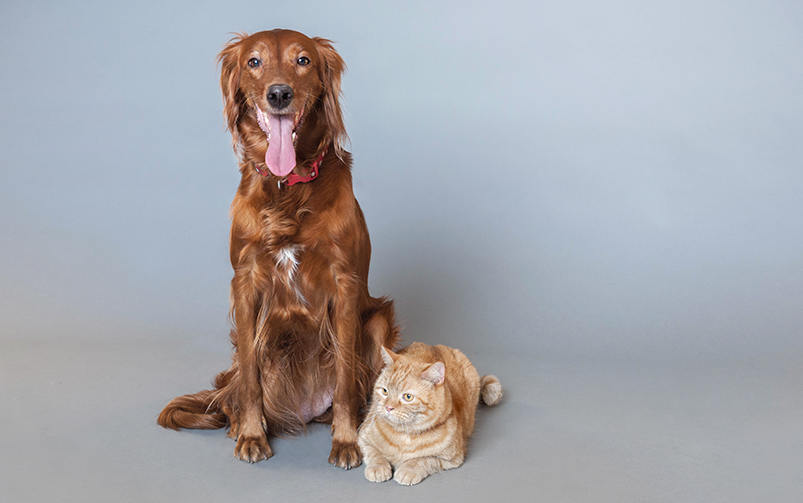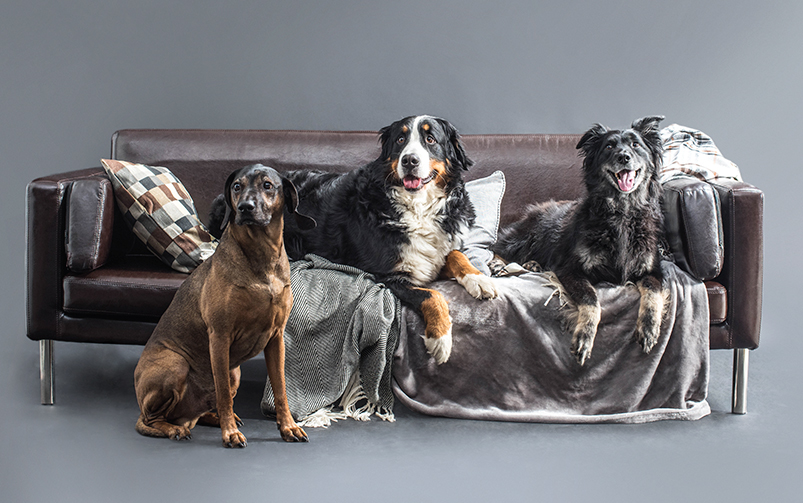4. Older dogs are not worth training
There is a saying: you can’t teach an old dog new tricks. It has little to do with truth. A dog can be trained regardless of age. This is important information, especially for those who decide to adopt an older dog from a shelter. It is really worth working with such a pet. Of course, a dog’s cognitive abilities – as well as a human’s – decline over time. This does not mean that it is better to drop out of school at a certain age. Contrary! Dog training is an opportunity to play together. It can bring not only the desired results, but also a lot of fun – especially when we use dog treats for learning. 🙂
5. Dogs hate cats
It’s not that dogs have a gene for hatred of cats. As a rule, different species of animals stick to their own, because they use a common language of gestures and sounds. The dog knows what the other dog is up to, but may have trouble interpreting the cat’s behavior. The body language of these quadrupeds is very different from each other and they just have a hard time getting along. It is different when the dog and the cat are brought up together from an early age. Not only do they find a common language, but sometimes they also become friends. Some dogs have a strong hunting instinct and are ready to chase anything that runs away, including cats. These behaviors can be learned by the dog thanks to proper training!
More about the life of a dog with a cat can be read in the article: Dog vs cat. The last clash! .

6. Small dogs don’t need a lot of exercise
There is a belief that the bigger the dog, the more exercise it needs. Therefore, should a Yorker be satisfied with three 15-minute walks a day? Definitely not. How much exercise a dog needs depends primarily on the breed. Some are famous for being bursting with energy (e.g. huskies), others like to laze around (e.g. English bulldogs). It is worth remembering that all dogs, regardless of their size, need longer walks and games in the fresh air. Two walks a day to the store and back is not enough even for a miniature chihuahua.
7. Purebred dogs get sick more often than mongrels
All dogs get sick. There are no statistics that would confirm the thesis that purebred dogs get sick more often than non-purebred dogs. There are, however, studies that show certain conditions are breed specific . This means that, for example, our German Shepherd Dog will be more prone to joint dysplasia than a dachshund. It’s a matter of genetics. Regardless of what kind of dog we have, whether purebred or non-purebred, let’s take care of his diet, move regularly, remember about care and visits to the vet. This will help prevent overweight and some diseases.

8. Dog saliva heals wounds
“Heal like a dog” means quick and easy. Many believe that dog saliva has magical properties that make wounds heal more easily. Yes, our pets’ saliva contains some substances that have disinfectant properties, but it also contains bacteria, viruses, and even fungi. Scientists urge us not to allow dogs to lick our wounds. Moreover, we should not allow them to lick their own! Then an infection may occur and a minor injury will grow to a very serious wound. It’s always better to go to the vet who will assess if suturing is needed, apply a dressing and give our pet medicine.
9. Some dog breeds are aggressive in nature
Amstaffs, Dobermans and Bull Terriers are called aggressive dogs. Some may even refer to them as “killer dogs.” This is a very damaging stereotype. Aggression is not a character trait, but a reaction to the situation. Any dog, no matter what breed it is, can be prone to showing aggression. The reasons are different: fear, a sense of threat, traumatic experiences, defense of the young against strangers, hunting instinct. It is up to the owner of the dog to decide whether his pet will show aggression or not. A mentally healthy and properly trained Amstaff can be a great family companion.

10. Wagging the tail is joy
We used to think that tail wagging is a clear expression of canine joy and excitement. In fact, dogs wag their tails at the footsteps of their handler, at the sight of a leash in his hand, or a bowl full of their favorite food. Consider the position of the entire body in order to properly read the message the dog is sending. For example, a stiff torso, closed mouth, and a jiggling, high-lift tail signal that the animal is disturbed or uncomfortable. Sometimes we can also notice a dog barking at us, running along the fence. He’s wagging his tail too, but to discourage us from coming closer. Dogs wag their tails also because their smell is better felt then.
